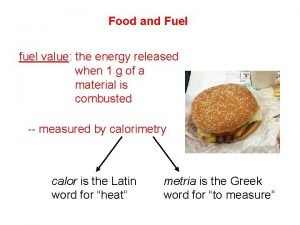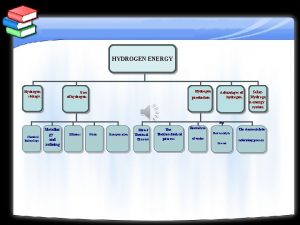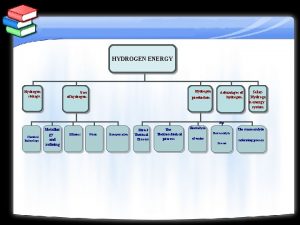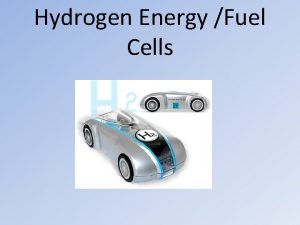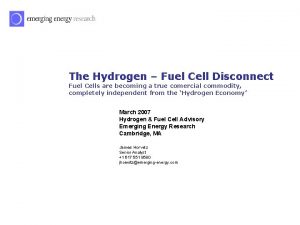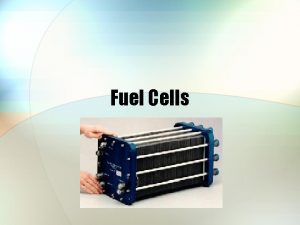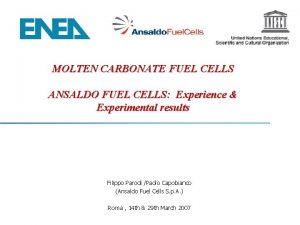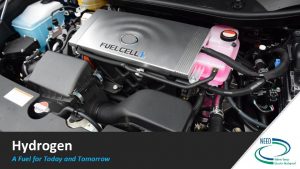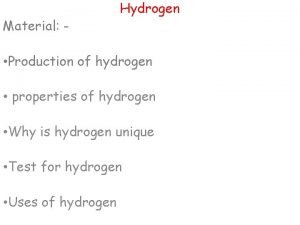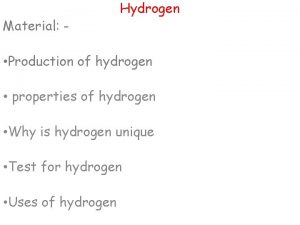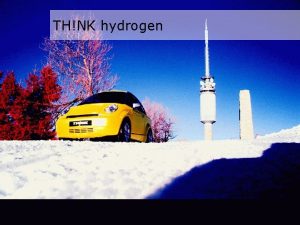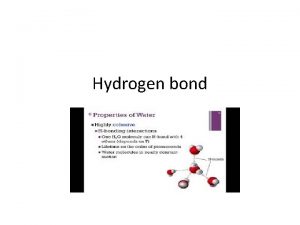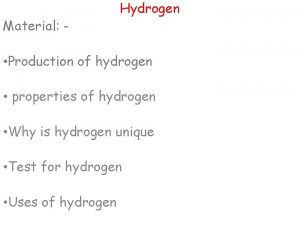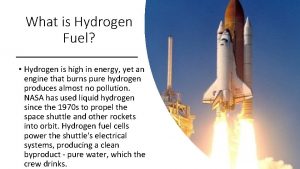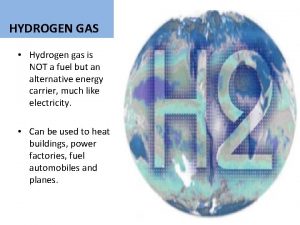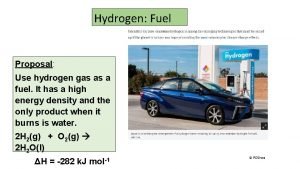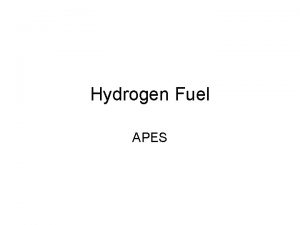Chapter 2 Fuel Cells and the Hydrogen Economy


































- Slides: 34

Chapter 2. Fuel Cells and the Hydrogen Economy Designing and Building Fuel Cells

Fuel Cells and the Hydrogen Economy Point • The Characteristics of Hydrogen • World Energy Demand • Development of the Hydrogen Economy • Hydrogen Production, Distribution, and Storage • Investment in the Hydrogen Infrastructure

2. 1 Characteristics of Hydrogen Table. Hydrogen Compared with Other Fuels

2. 1 Characteristics of Hydrogen does not exist in its natural form on earth; therefore, it must be manufactured through one of various ways: the steam reforming of natural gas, the gasification of coal, electrolysis, or the reforming/oxidation of other hydrocarbons or biomass.

2. 1 Characteristics of Hydrogen is a good choice for a future energy source for many reasons. • Hydrogen can be made from various sources. It is completely renewable. • Hydrogen can be stored in many forms, from gaseous to liquid to solid. It can also be stored in various chemicals and substances such as methanol, and metal hydrides. • It can be produced from, and converted to, electricity with high efficiencies. • It can be transported and stored as safely as any other fuel.

2. 1 Characteristics of Hydrogen and other fuels for fuel cells can be made cheaply and easily by processing hydrocarbons. Hydrogen has the potential to provide energy to all parts of the economy: industry, residences, transportation, and mobile applications. It can eventually replace petroleum-based fuels used for automobiles, and may provide an attractive solution for remote communities that cannot obtain electricity through the grid. One of the main attractions for using hydrogen is its environmental advantage over fossil fuels-but the hydrogen is only as clean as the technologies used to produce it.

2. 1 Characteristics of Hydrogen

2. 1 Characteristics of Hydrogen The production of hydrogen can be pollutant-free if it is produced by one of three methods. • Through electrolysis using electricity derived solely from nuclear power or renewable energy sources. • Through steam reforming of fossil fuels combined with new carbon capture and storage technologies. • Through thermochemical or biological techniques based on renewable biomass

2. 1. 1 Safety aspects of hydrogen as a fuel One of the critical issues with the use of hydrogen is safety. Contrary to popular perception, hydrogen is less flammable than gasoline and other fossil fuels. Like any other fuel, hydrogen has risks if not properly stored or transported. Since hydrogen is a small molecule, it has a tendency to escape through small openings more so than other gaseous or liquid fuels. Hydrogen will tend to leak through holes or joints of low pressure fuel lines only 1. 26 to 2. 8 times faster than a natural gas leak through the same hole.

2. 1. 1 Safety aspects of hydrogen as a fuel The fuel cell has a lower hazard than the hydrogen fuel. Small amounts of hydrogen and oxygen do exist in the fuel cell, but they are separated by a thin electrolyte layer. A fuel cell system has controls with detailed safety algorithms that will disconnect the fuel supply lines in case of fuel mixing, fuel leaks or other safety hazards.

2. 1. 1 Safety aspects of hydrogen as a fuel When designing hydrogen systems, many safety factors need to be considered: • A catastrophic rupture due to a defect in the tank or puncture by a sharp object. • Mixture of fuel cell reactants in the cell. • A large leak due to faulty controls or a puncture. • A slow leak due to stress cracks in the tank liner, or pressure relief valve.

2. 1. 1 Safety aspects of hydrogen as a fuel In addition to having a robust control system with detailed safety algorithms, these failure modes can be prevented in many ways. • Leak prevention through thorough testing of tanks and equipment. • Installing more than one valve. • Designing equipment for shocks, vibrations, and wide temperature ranges. • Adding several hydrogen or oxygen sensors or leak detectors. • Ignition prevention by illuminating a source of electrical sparks. • Designing fuel cell supply lines that are physically separated from other equipment.

2. 2 World Energy Demand International energy consumption is estimated to increase by 2. 0 percent per year from 2003 to 2030. year Fig. World energy consumption, 1980 -2030

2. 2 World Energy Demand Since the need for energy is increasing rapidly (as shown in Figures),it is critical to obtain a low-emission power technology for the future. (year) Fig. World delivered energy consumption by end use sector, 2003 -2030

2. 3 Development of the Hydrogen Economy Technologies to produce, store, transport, and convert hydrogen have already been in use for many years. Fuel cells have been extensively researched by most large car manufacturers, and prototypes are currently being driven around the country. Fuel cells that supply power to remote communities are ready to come to market. Portable fuel cells have been demonstrated and are close to commercialization. Many governments along with the major oil and coal companies have been researching and developing carbon capture and storage for more than a decade. Several technological and cost breakthroughs are necessary for the hydrogen economy to become a reality.

2. 4. Hydrogen Production, Distribution, and Storage The most common methods of producing hydrogen are described in the next few paragraphs. • Steam reforming. The cheapest method of producing hydrogen on a large scale is through steam reforming of fossil fuels. The current methods use a nickel catalyst. CH 4+ H 2 O → CO+3 H 2 CO+H 2 O → CO 2+H 2

2. 4. Hydrogen Production, Distribution, and Storage • Partial oxidation Another method used to produce hydrogen is partial oxidation. This process involves reacting the membrane with oxygen to produce hydrogen and carbon monoxide. The conversion efficiency is lower than steam reforming.

2. 4. Hydrogen Production, Distribution, and Storage • Coal gasification The gasification of coal is one of the oldest methods for producing hydrogen. It was used to produce “town gas" before natural gas became available. The coal is heated to a gaseous state, then mixed with steam in the presence of a catalyst to produce synthesis gas.

2. 4. Hydrogen Production, Distribution, and Storage • Biomass Hydrogen can be produced from many types of biomass such as agricultural and animal Residues using pyrolysis and gasification processes. These produce a carbon-rich synthesis gas. Using biomass instead of fossil fuels produce no carbon dioxide emissions. Unfortunately, biomass hydrogen production costs are much higher than hydrogen Production costs from fossil fuels.

2. 4. Hydrogen Production, Distribution, and Storage • Water electrolysis Hydrogen production using water electrolysis is seldom used due to the cost of electricity. This technique is employed when Extremely pure hydrogen is needed.

2. 4. Hydrogen Production, Distribution, and Storage • Metal hydrides applications Hydrogen’s ability to form metal hydrides can also be used for energy conversion. In order for hydrogen to be released, heat must be applied. The heat generated during the charging and discharging process are functions of the hydrating substance, hydrogen pressure, and the temperature at whichthe heat is supplied or extracted.

2. 4. 2 Technologies for hydrogen storage The most common storage method is the pressurized storage tank, which is available in many sizes and pressure ranges. • Large underground storage. • Vehicular pressurized hydrogen tanks • Liquid hydrogen storage • Metal hydride storage • Novel hydrogen storage methods

2. 4. 3 Worldwide hydrogen refueling stations Certain countries, such as Germany, will begin rapidly introducing hydrogen refueling stations during the next five years. The more rapid introduction is due to several reasons : • Many fuel cell vehicle manufacturers will not begin vehicle production for a niche market. • Both the automotive industry and fuel suppliers need to mass produce a certain number of units in order to reduce cost. • Consumers will not accept a fuel that is not “widely available. “ • There is an alternative fuel and vehicle market in Brazil and Argentina. TABLE 2 -2 Worldwide Fueling Stations (Compiled from Fuel Cells 2000)

2. 5 Investment of Hydrogen Infrastructure Figure shows a diagram of how current and future technologies can create hydrogen and other fuels simultaneously. Coal Vehicles Gasification Biomass Hydrogen Production Industry Electricity Oil/Natural Gas Wind, Nuclear, Solar Electrolysis Steam Reforming Hydrogen Storage Fuel Cell Fig. Hydrogen linkages with the energy system. Residences

2. 5 Investment of Hydrogen Infrastructure As mentioned previously, in order to successfully convert the oil-based infrastructure to a hydrogen one, a radical transformation of the global energy-supply system is required. A large infrastructure to store, distribute, and transport hydrogen would need to be built, and consumers need to be interested in purchasing fuel cell vehicles and other fuel cell products. The total cost of building a hydrogen infrastructure would depend on when and how fast it is built. Even if hydrogen only replaced petroleum-based fuels for automobiles, the cost of converting this structure would probably be in the trillions of dollars. The cost of replacing all vehicles currently used (∼ 800 million vehicles) with fuel cell vehicles is estimated to be $2 trillion, if the average vehicle is estimated to cost $2500 more than a conventional vehicle. The cost of developing the rest of the necessary hydrogen infrastructure would be about $8 trillion.

2. 5 Investment of Hydrogen Infrastructure The main barrier to converting the economy to hydrogen is cost. In order to begin the conversion to the hydrogen economy, the hydrogen infrastructure needs to be established where fuel costs are extremely high and/or where there is public concern for the environment. These factors, combined with government incentives, will help the hydrogen market to develop. As the supply and demand increases for hydrogen, mass production of hydrogen equipment and fuel cells will lower the costs and make using hydrogen a more popular option. A major factor in implementing the hydrogen economy is a strong, longterm commitment by governments. This will encourage fuel suppliers and equipment manufacturers and increase consumer’s confidence in the new energy source.

2. 5. 1 Government support In order to begin the transition to the hydrogen economy, there is a need for government help in two major areas. • The research and development of hydrogen fuel cells • Incentive to encourage investment in the hydrogen infrastructure Government, public, and private funding for fuel cell research has increased tremendously during the last decade.

2. 5. 2 Long-term projections of hydrogen use • It is difficult to predict how soon the transition to a hydrogen economy will occur. • The transition will undoubtedly take several decades. • The construction, operation, and decommissioning of the current structure will take at least 10 to 20 years.

2. 5. 3 Key players in hydrogen R&D Many countries have active fuel cell programs with worldwide public funding at $1 billion per year. The United States 2000 2010 2020 2015 : Commercialization Decision for U. S. 2030 Research & Development Manufacturing R&D Transition to Market place Expansion of Markets and Infrastructure Fig. The U. S. hydrogen economy timeline Realization of the Hydrogen Economy

2. 5. 3 Key players in hydrogen R&D The DOE has identified four phases in the transition to the hydrogen economy : 1. The government and private sector will conduct R&D and develop industry standards. In 2015, the administration will make a decision on whether the technologies will be commercialized in the near term, and how much R&D should be continued. 2. As early as 2010, the government will begin modification of the existing infrastructure to support hydrogen applications. 3. The government will begin implementing a large-scale infrastructure for manufacturing fuel cells and distributing hydrogen. 4. The realization of the hydrogen economy is projected to begin in 2025.

2. 5. 3 Key players in hydrogen R&D Japan 2000 2010 2020 2030 Research & Development Manufacturing R&D Transition to Market place Expansion of Markets and Infrastructure Realization of the Hydrogen Economy Fig. The Japen hydrogen economy timeline

2. 5. 3 Key players in hydrogen R&D The Japanese government believes fuel cells will be competitive within the next two decades. The NEP sets target dates of 2010 and 2020 for the introduction of fuel cell vehicles, refueling stations, and stationary power. The NEP has identified three stages in the transition to the hydrogen economy : 1. The initial stage was completed in 2005 and focused on fuel cell technology development and standards. 2. The induction stage will end in 2010 and involves the acceleration of vehicle sales while constructing the refueling infrastructure. 3. The diffusion stage will be from 2011 to 2020 and will continue to set up the infrastructure started in the second stage.

2. 5. 3 Key players in hydrogen R&D The European Union European funding for hydrogen and fuel cell R&D is provided under the Renewable Energy Sixth Framework Programme, which ran from 2002 to 2006. All of the hydrogen projects funded by the European Union are in support of the Quick Start initiative. This program aims to attract private investment and accelerate the commercialization of fuel cells. Other production-related projects are aimed at building large demonstration plants that can produce electricity and hydrogen, as well as separate and store the CO₂ created in the process. Projects have also been designated that will create hydrogen communities with a centralized and decentralized hydrogen infrastructure, hydrogen vehicles, and a refueling structure.

2. 5. 3 Key players in hydrogen R&D The European Union Research will also be conducted for different hydrogen production processes, including wind and biomass. Programs in other countries. Many programs exist in other countries, including Australia, Canada, France, Germany, Italy, Korea, China, India, Russia, and Brazil. Projects are usually conducted in collaboration with private organizations.
 Valuetheenergy.com
Valuetheenergy.com Nondisjunction in meiosis
Nondisjunction in meiosis Athenian economy vs sparta economy
Athenian economy vs sparta economy Paranasal sinuses development
Paranasal sinuses development Red blood cells and white blood cells difference
Red blood cells and white blood cells difference Plant cell vs animal cell venn diagram
Plant cell vs animal cell venn diagram Masses of cells form and steal nutrients from healthy cells
Masses of cells form and steal nutrients from healthy cells Dr saja
Dr saja Pineal gland
Pineal gland Somatic vs gamete
Somatic vs gamete Why dna is more stable than rna?
Why dna is more stable than rna? Eukaryotic life
Eukaryotic life Prokaryotic cells vs eukaryotic cells
Prokaryotic cells vs eukaryotic cells Why did robert hooke name cells “cells”?
Why did robert hooke name cells “cells”? Younger cells cuboidal older cells flattened
Younger cells cuboidal older cells flattened 4 types of eukaryotic cells
4 types of eukaryotic cells Prokaryotic vs eukaryotic cells
Prokaryotic vs eukaryotic cells Cells cells they're made of organelles meme
Cells cells they're made of organelles meme Hình ảnh bộ gõ cơ thể búng tay
Hình ảnh bộ gõ cơ thể búng tay Bổ thể
Bổ thể Tỉ lệ cơ thể trẻ em
Tỉ lệ cơ thể trẻ em Voi kéo gỗ như thế nào
Voi kéo gỗ như thế nào Chụp tư thế worms-breton
Chụp tư thế worms-breton Chúa yêu trần thế alleluia
Chúa yêu trần thế alleluia Các môn thể thao bắt đầu bằng tiếng đua
Các môn thể thao bắt đầu bằng tiếng đua Thế nào là hệ số cao nhất
Thế nào là hệ số cao nhất Các châu lục và đại dương trên thế giới
Các châu lục và đại dương trên thế giới Công của trọng lực
Công của trọng lực Trời xanh đây là của chúng ta thể thơ
Trời xanh đây là của chúng ta thể thơ Cách giải mật thư tọa độ
Cách giải mật thư tọa độ 101012 bằng
101012 bằng độ dài liên kết
độ dài liên kết Các châu lục và đại dương trên thế giới
Các châu lục và đại dương trên thế giới Thể thơ truyền thống
Thể thơ truyền thống
